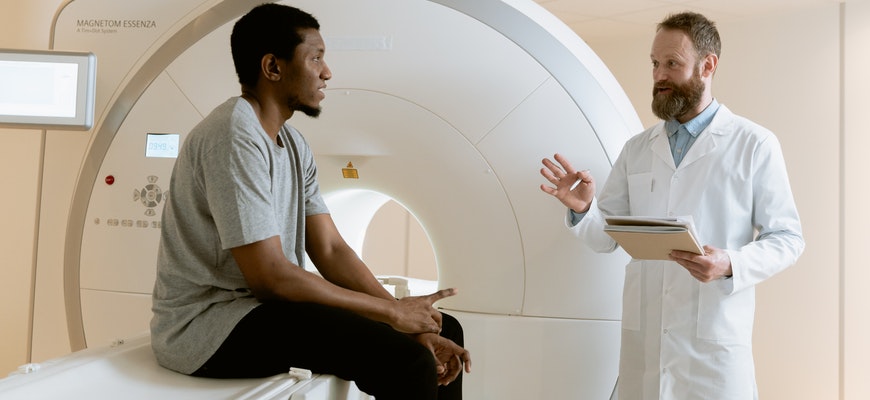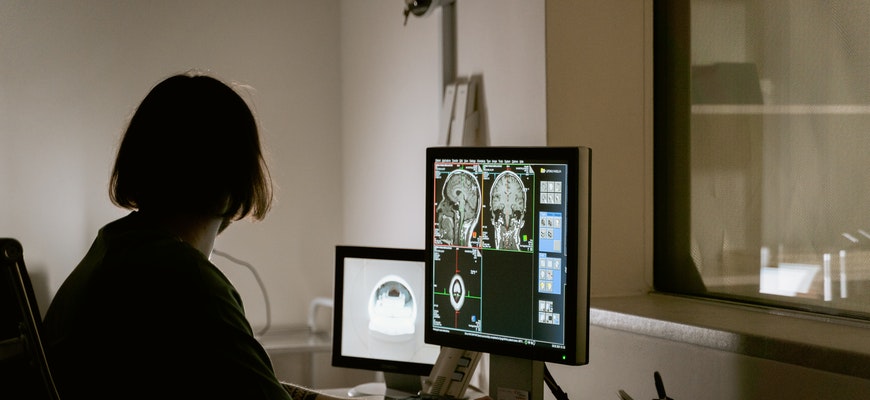Calls for Ukraine
Calls for Europe
Calls for USA

Glioblastoma – the most malignant and aggressive brain tumor that causes frequent relapses. The neoplasm develops from auxiliary glial cells of the brain. These cells mutate, becoming cancerous and dividing uncontrollably. The tumor rarely extends beyond the skull and usually does not metastasize. Glioblastoma grows rapidly and penetrates into various structures of the brain, damaging them.
The exact cause of the development of glioblastoma has not been established. It is known to be a multifactorial disease.
Adverse risk factors for the development of glioblastoma include:
There are two types of glioblastomas:
The clinical picture depends on the location of the tumor, its size and growth rate.
Glioblastoma causes an increase in pressure inside the skull and compresses the brain structures. This leads to the appearance of general symptoms:
Each structure in the brain is responsible for specific functions. Depending on which part of the brain is affected, specific symptoms may occur:

The doctor will order tests to confirm the diagnosis if a brain tumor is suspected.
MRI with contrast is a mandatory examination if a brain neoplasm is suspected. Magnetic resonance imaging (MRI) gives the doctor a visualization of the tumor, its size, location, and complications (for example, swelling of the brain). If the patient has contraindications to MRI, the doctor will prescribe a CT scan.
Examples of the cost of MRI in clinics around the world:
The symptoms of glioblastoma are similar to those of other diseases. In order to make a correct diagnosis, foreign doctors use MRS (magnetic-resonance spectroscopy).
A biopsy is done to confirm the diagnosis of glioblastoma. The doctor will remove a small piece of the tumor for further examination under a microscope. Sometimes this diagnostic method is not used and tumor treatment can begin immediately after receiving an MRI report.
Glioblastoma is characterized by rapid growth. Therefore, it is important to start treatment as early as possible.
Early diagnosis and complex therapy of the tumor improves the prognosis.
Survival over 3 years is influenced by: the patient’s age, chemotherapy, positive response to treatment, tumor removal over 70%, repeated radiation therapy.

Glioblastoma is a glial brain tumor. The World Health Organization has classified brain tumors into 4 grades.
Tumors of the 1st degree are low-grade, they grow slowly and have a high survival rate.
Glioblastoma belongs to the 4th degree of malignancy. This means that the neoplasm is more aggressive than the 1-3 stages of tumors.

The treatment plan is developed by a multidisciplinary team of doctors, consisting of: a radiologist, oncologist, neurosurgeon, neuro-oncologist, pathologist and neuroradiologist.
Therapy for glioblastoma consists of microsurgical surgery to remove the tumor in combination with radiation therapy and chemotherapy. Also, it is often necessary to treat complications that arise from the spread of the tumor and compression of important parts of the brain. These complications may include seizures, cerebral edema, or deep vein thromboembolism.
Microsurgery (resection)
This is the main treatment for glioblastoma. For maximum removal of cancerous tissue, the operation is performed by an experienced surgeon.
Due to the fact that glioblastoma grows in the structures of the brain, the tumor cannot be completely removed by surgery. For the complete destruction of the neoplasm, it is necessary to carry out radiation and chemotherapy.
During the operation, the team of doctors can perform an intraoperative MRI. After the surgeon removes the tumor, the patient is transferred to an MRI machine while still under anesthesia. If the examination reveals remnants of the tumor, the doctor will remove them without interrupting the operation.
Gamma Knife
Gamma Knife is a radiosurgical treatment method. It is considered an adjunct therapy for glioblastoma. The radiologist determines the exact location of the tumor where the radiation will be directed. This method is aimed at destroying the tumor. Healthy cells are not damaged.
Examples of the cost of the Gamma Knife procedure in clinics around the world:
Radiation therapy
This radiation, which leads to the death of tumor cells, reduces the likelihood of recurrence and relieves the manifestation of the disease. There are 30 radiation sessions over 6 weeks.
For inoperable glioblastoma, radiation therapy is used as the primary treatment.
Chemotherapy
Chemotherapy is given in parallel with radiation therapy.
In total, 6 cycles of chemotherapy with the drug with the active substance temozolomide are required. First, the tablets are taken daily, then a cycle of 5 days is performed every 4 weeks.

Tumor Treating Fields – TTFields
This is an innovative non-traumatic treatment for brain tumors. The method slows down or stops the division of cancer cells without damaging healthy tissue.
TTFields is prescribed in combination with temozolomide chemotherapy. The apparatus for TTFields is attached to the scalp. The patient must wear the device for at least 18 hours a day, for at least 4 weeks.
Biological (targeted) therapy
Targeted therapy is a modern approach to the treatment of malignant neoplasms. Targeted drugs affect the growth mechanisms of cancer cells, which blocks tumor division and spread.
Targeted therapy uses monoclonal antibodies, vaccines, and gene therapy. This type of treatment is less toxic to healthy cells than radiation and chemotherapy.
Glioblastoma is incurable. Since the tumor has an extremely poor prognosis, treatment is aimed not at complete recovery, but at reducing symptoms and prolonging life with an improvement in its quality.
The final cost is influenced by the amount of studies prescribed by the doctor, the method of surgical treatment and courses of therapy. This depends on many factors, such as the age of the patient, the size of the tumor, and the extent to which it has spread to surrounding tissues.
MedTour recommends undergoing diagnostics and treatment in specialized clinics that have experience working with glioblastomas and are equipped with the necessary modern equipment. Leave a request on the MedTour platform and the coordinating doctor will contact you. Our experts will help with air travel, booking an apartment near the clinic for accompanying persons and transfer.
Please rate the work of MedTour
